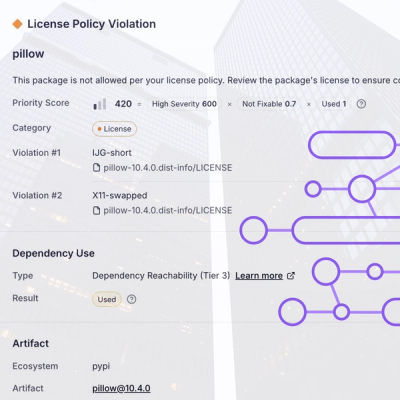
Research
/Security News
Critical Vulnerability in NestJS Devtools: Localhost RCE via Sandbox Escape
A flawed sandbox in @nestjs/devtools-integration lets attackers run code on your machine via CSRF, leading to full Remote Code Execution (RCE).
A tiny library which provides utility types/functions for request and response query handling.
Rapiq (Rest Api Query) is a library to build an efficient interface between client- & server-side applications. It defines a scheme for the request, but not for the response.
Table of Contents
npm install rapiq --save
To read the docs, visit https://rapiq.tada5hi.net
fields
filters
relations
pagination
sort
It is based on the JSON-API specification.
This is a small outlook on how to use the library. For detailed explanations and extended examples, read the docs.
The first step is to construct a BuildInput object for a generic Record <T>.
Pass the object to the buildQuery method to convert it to a transportable string.
The BuildInput<T> can contain a configuration for each
Parameter/
URLParameter.
FieldsBuildInput<T>FiltersBuildInput<T>PaginationBuildInput<T>RelationsBuildInput<T>SortBuildInput<T>NOTE: Check out the API-Reference of each parameter for acceptable input formats and examples.
After building, the string can be passed to a backend application as http query string argument. The backend application can process the request, by parsing the query string.
The following example is based on the assumption, that the following packages are installed:
It should give an insight on how to use this library.
Therefore, a type which will represent a User and a method getAPIUsers are defined.
The method should perform a request to the resource API to receive a collection of entities.
import axios from "axios";
import {
buildQuery,
BuildInput
} from "rapiq";
export type Realm = {
id: string,
name: string,
description: string,
}
export type Item = {
id: string,
realm: Realm,
user: User
}
export type User = {
id: number,
name: string,
email: string,
age: number,
realm: Realm,
items: Item[]
}
type ResponsePayload = {
data: User[],
meta: {
limit: number,
offset: number,
total: number
}
}
const record: BuildInput<User> = {
pagination: {
limit: 20,
offset: 10
},
filters: {
id: 1
},
fields: ['id', 'name'],
sort: '-id',
relations: ['realm']
};
const query = buildQuery(record);
// console.log(query);
// ?filter[id]=1&fields=id,name&page[limit]=20&page[offset]=10&sort=-id&include=realm
async function getAPIUsers(
record: BuildInput<User>
): Promise<ResponsePayload> {
const response = await axios.get('users' + buildQuery(record));
return response.data;
}
(async () => {
let response = await getAPIUsers(record);
// do something with the response :)
})();
The next section will describe, how to parse the query string on the backend side.
The last step of the whole process is to parse the transpiled query string, to an efficient data structure.
The result object (ParseOutput) can contain an output for each
Parameter/
URLParameter.
FieldsParseOutput<T>FiltersParseOutput<T>PaginationParseOutput<T>RelationsParseOutput<T>SortParseOutput<T>NOTE: Check out the API-Reference of each parameter for output formats and examples.
The following example is based on the assumption, that the following packages are installed:
For explanation purposes, three simple entities with relations between them are declared to demonstrate the usage on the backend side.
entities.ts
import {
Entity,
PrimaryGeneratedColumn,
Column,
OneToMany,
JoinColumn,
ManyToOne
} from "typeorm";
@Entity()
export class User {
@PrimaryGeneratedColumn({unsigned: true})
id: number;
@Column({type: 'varchar', length: 30})
@Index({unique: true})
name: string;
@Column({type: 'varchar', length: 255, default: null, nullable: true})
email: string;
@Column({type: 'int', nullable: true})
age: number
@ManyToOne(() => Realm, { onDelete: 'CASCADE' })
realm: Realm;
@OneToMany(() => User, { onDelete: 'CASCADE' })
items: Item[];
}
@Entity()
export class Realm {
@PrimaryColumn({ type: 'varchar', length: 36 })
id: string;
@Column({ type: 'varchar', length: 128, unique: true })
name: string;
@Column({ type: 'text', nullable: true, default: null })
description: string | null;
}
@Entity()
export class Item {
@PrimaryGeneratedColumn({unsigned: true})
id: number;
@ManyToOne(() => Realm, { onDelete: 'CASCADE' })
realm: Realm;
@ManyToOne(() => User, { onDelete: 'CASCADE' })
user: User;
}
import { Request, Response } from 'express';
import {
applyQuery,
useDataSource
} from 'typeorm-extension';
/**
* Get many users.
*
* Request example
* - url: /users?page[limit]=10&page[offset]=0&include=realm&filter[id]=1&fields=id,name
*
* @param req
* @param res
*/
export async function getUsers(req: Request, res: Response) {
const dataSource = await useDataSource();
const repository = dataSource.getRepository(User);
const query = repository.createQueryBuilder('user');
// -----------------------------------------------------
// parse and apply data on the db query.
const { pagination } = applyQuery(query, req.query, {
defaultPath: 'user',
fields: {
allowed: ['id', 'name', 'realm.id', 'realm.name'],
},
filters: {
allowed: ['id', 'name', 'realm.id'],
},
relations: {
allowed: ['items', 'realm']
},
pagination: {
maxLimit: 20
},
sort: {
allowed: ['id', 'name', 'realm.id'],
}
});
// -----------------------------------------------------
const [entities, total] = await query.getManyAndCount();
return res.json({
data: {
data: entities,
meta: {
total,
...pagination
}
}
});
}
Made with 💚
Published under MIT License.
FAQs
A tiny library which provides utility types/functions for request and response query handling.
The npm package rapiq receives a total of 0 weekly downloads. As such, rapiq popularity was classified as not popular.
We found that rapiq demonstrated a healthy version release cadence and project activity because the last version was released less than a year ago. It has 1 open source maintainer collaborating on the project.
Did you know?

Socket for GitHub automatically highlights issues in each pull request and monitors the health of all your open source dependencies. Discover the contents of your packages and block harmful activity before you install or update your dependencies.

Research
/Security News
A flawed sandbox in @nestjs/devtools-integration lets attackers run code on your machine via CSRF, leading to full Remote Code Execution (RCE).

Product
Customize license detection with Socket’s new license overlays: gain control, reduce noise, and handle edge cases with precision.

Product
Socket now supports Rust and Cargo, offering package search for all users and experimental SBOM generation for enterprise projects.